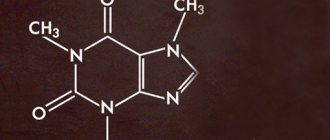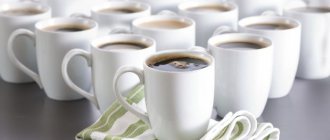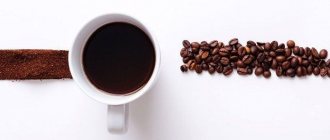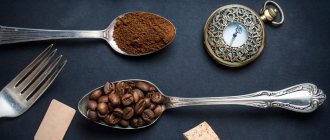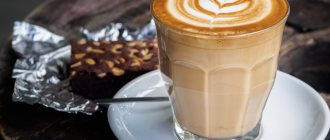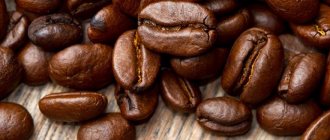Effect of caffeine on the human body
Probably everyone knows that caffeine speeds up the heartbeat and dilates blood vessels. But not many people know that there is a complex effect on metabolism. When you drink a drink that contains caffeine, the amount of adrenaline in your body increases, and this directly affects your mental state and metabolism.
Scientists say that fifty milligrams of caffeine will improve mood and increase productivity, but two hundred or three hundred milligrams will lead to heartbeat disturbances and mild tachycardia.
Consuming four hundred to five hundred milligrams can provoke depression. If you decide to drink a liter of caffeine, death will occur.
But how do you know how much caffeine is in your cup?
Why does caffeine cause anxiety?
It is estimated that 80% of the world's population consumes a caffeinated product daily.
The United States Department of Agriculture (USDA) and the European Food Safety Authority (EFSA) define a safe level of caffeine intake at 400 mg per day, 200 mg as a single dose, or 3 mg per kg of body weight (, ,).
Due to its stimulant effects, caffeine has been linked to benefits such as improved concentration, athletic performance, mood, and increased metabolism (, , , ).
However, consuming large amounts—such as single doses over 500 mg—may raise some concerns (,).
In high doses, caffeine has been linked to anxiety, restlessness and sleep problems. In addition, some studies show that its regular consumption, even in moderate quantities, can cause chronic headaches and migraines (, ,).
Additionally, caffeine is considered mildly addictive and some people may be more susceptible to developing dependence ().
Summary:
Caffeine is a popular stimulant compound found in many foods and drinks, including coffee and tea. It has many beneficial properties, but excessive consumption may cause some side effects.
Table of caffeine content in coffee drinks
It is important to understand that the amount of caffeine ultimately depends on the starting raw material, brewing method and time. The quantity is also affected by the portion. For example, espresso has a serving of thirty milligrams, which means forty to seventy-five milligrams of caffeine.
It is a misconception that tea does not contain as much caffeine as coffee. For example, a small cup of instant coffee will have less caffeine than a large cup of strongly brewed tea. By the way, caffeine is also found in carbonated drinks.
Caffeine Content Table
| Drink, ml | Amount of caffeine (approximately, mg) |
| Natural coffee, 250 | 100-200 |
| Instant coffee, 100 | 30-50 |
| Decaffeinated coffee, 250 | 2-30 |
| Espresso, 30 | 40-75 |
| Black tea, 100 | 40-50 |
| Green tea, 100 | 20-30 |
| Energy, 250 | 70-100 |
| Drink with gases, 330 | 20-40 |
| Iced tea in bottles, 330 | 5-40 |
| Hot chocolate drink, 240 | 5-10 |
| Chocolate ice cream | 30-45 |
| Dark chocolate, 100 g | 30-50 |
Alkaloid in tea: what the indicators depend on
Just like in coffee, contrary to popular belief that it is almost completely harmless, caffeine is also present in tea. Its level is influenced by several factors:
- tea leaf quality;
- fermentation level;
- type of preparation;
- variety;
- concentration.
If the answer to the question of whether there is caffeine in tea is unequivocally affirmative, then the amount of it is worth arguing about. The quality of the sheet in this case is almost of key importance. Traditionally, several groups of leaves and tips (buds) are used for production.
The highest amount of caffeine is found in the top leaves. As they decrease, the proportion of caffeine also decreases. The lower shoots contain less than 1% caffeine. The price of finished tea also depends on this indicator. Expensive elite varieties are produced from the upper shoots, and cheap ones from the lower shoots. The more expensive the drink, the more caffeine it contains. At the same time, the so-called decaffeinated tea is in most cases made from the lowest shoots and still contains it in small quantities.
You may be interested in Instant coffee - benefits and harms
The degree of fermentation, that is, the level of processing of raw materials, also plays a role. The amount of natural substances preserved in the leaves increases caffeine levels. According to this indicator, the strongest is green tea, which undergoes the least processing.
One cup of green tea contains from 50 to 70 mg of caffeine, while in its black counterpart its amount is almost halved.
The indicators provide a clear answer to the question of whether there is caffeine in green tea; moreover, they prove that green does not always mean healthier and safer.
What harm does coffee cause?
Two hundred to three hundred milligrams per day is considered a safe amount of coffee for humans. According to the caffeine content table, this is approximately three cups of espresso.
As you know, caffeine addiction exists. But it appears if you consume more than three hundred to five hundred milligrams per day. A one-time intake of half a liter of caffeine has a bad effect on the human psyche.
Scientists say that large amounts of caffeine provoke paranoia and anxiety attacks. Many people know that if you drink too much coffee, insomnia becomes your best friend.
Caffeine component - which is more in tea leaves or coffee beans?
As mentioned above, caffeine is white or colorless crystals with a bitter aftertaste. If you consume it in moderation, you can achieve a positive effect on the functioning of the nervous and cardiac systems, as well as the body as a whole.
The main difficulty is that the reaction to this component may differ depending on the characteristics of the body. If one small cup of Americano is enough for one person to tone up, then for another a few stronger shots of espresso will not be enough to achieve the same goal.
Below is a table of caffeine content in tea and coffee for comparison:
| Drink name | Portion, l | Caffeine, g |
| Ground coffee | 0, 24 | 0,1-0,2 |
| Instant coffee drink | 0,24 | 0,08-0,1 |
| Decaffeinated coffee | 0,24 | 0,003-0,005 |
| Black tea | 0,24 | 0,043-0,05 |
| Green tea | 0,24 | 0,03 |
The table shows that the most caffeine is found in ground coffee and green tea.
Advantages and Disadvantages of Quitting Caffeine
Caffeine is only effective if you consume it only occasionally. But if you are a daily coffee drinker, you will start to feel uncomfortable when you give it up.
Headache, decreased activity, insomnia are the consequences of abrupt caffeine withdrawal. Usually such symptoms disappear after three to four days.
Conclusion
The amount of caffeine depends on the quality of the product and the brewing method. As you can see from the caffeine content table, instant coffee generally does not contain much more caffeine than black tea. When taking energy drinks, the effect of caffeine becomes more pronounced.
Useful information about tea caffeine
The caffeine contained in tea and coffee is a significant difference between them. And this is due to a number of factors.
The tonic crystals that make up the tea are scientifically called tannin. It was discovered at the beginning of the 19th century and was initially classified as a separate group of alkaloids. Only a century later, pure caffeine was extracted from tea leaves, and a few years later they came to the conclusion that it is the same as tannin. This finding led to the conclusion that tea and coffee contain the same caffeine. At the same time, the effect of drinks on the body is different, which means that something changes the effect of alkaloids.
You might be interested in The effect of coffee on human health
Over time, it turned out that the tannin in tea leaves partially blocks the effect of caffeine, so the effect of espresso, for example, and a Lipton cup varies. Drinking a cup of coffee makes a person feel cheerful, energetic and even happy. The sensation lasts about 30-40 minutes of caffeine action. After tea, the effect of invigoration is longer lasting, even despite the high level of concentration in the first drink.
Unlike coffee beans brewed in one way or another, tea is perfectly refreshing and helps to invigorate, quenching thirst. It is not for nothing that in some countries the tea drinking ceremony is a national tradition that has not become obsolete even after the discovery of the properties of coffee.
Decaf Green Tea: Fiction or Truth
There are two known ways to neutralize the effects of caffeine. The first is considered less harmful because it occurs without the use of chemicals. CO2 – extraction or “fizzing”, done using carbon dioxide and water. The advantage of the procedure is that it retains more than 90% of beneficial polyphenols and antioxidants. Dry leaves are placed in a chamber with liquefied gas under pressure. After 10-12 hours, it is released, the gas evaporates, and the caffeine is filtered out. The taste of the product remains excellent after removing unwanted components. This justifies the high cost of the process.
The second option is to use a chemical solvent - ethyl acetate. The leaves are soaked in it for several hours, it draws out and dissolves the alkaloid. “Natural neutralization” has been used for a long time and is a budget alternative. Using it, manufacturers retain only 20-30% of useful components.
Any technology changes the taste of the finished drink; information about it must be contained on the label.
Decaffeination does not lead to absolute elimination of the psychostimulant. It simply becomes negligible. If you have an allergy to a component or an individual intolerance, choose “non-tea” infusions: berry, fruit or flower.
“Caffeine-free” drink options for connoisseurs of taste are not harmful to health
There is no caffeine, for example, in Ivan tea - a plant with a number of useful components:
- iron;
- copper;
- boron;
- manganese;
- nickel;
- lithium;
- potassium;
- sodium;
- calcium;
- pectin;
- molybdenum
Tea breaks all records for the content of vitamin C and B vitamins, surpassing in this regard the rich sources of vitamins orange, lemon and black currant. In addition, fireweed tea contains quickly digestible protein; in addition to caffeine, there are no uric, oxalic and puric acids that negatively affect metabolism.
In addition to fireweed, herbal infusions that can be prepared at home, for example, from linden and chamomile flowers, or purchased ready-made at a pharmacy, are safe and healthy.
In conclusion, we note that a healthy person can afford a small daily dose of caffeine. On average, this is from 100 to 200 mg at a time and no more than 1000 mg per day, depending on age, weight, and health status.
To answer the question of how much caffeine is in a cup of tea or coffee, you need to know several nuances regarding the preparation of these drinks. With this information, you can choose the optimal drink that will not negatively affect your health.
Conclusions:
- Tea leaves and buds collected from a tea bush always contain caffeine, the only difference is in its quantity.
- All drinks made from herbs, fruits, leaves, and even fireweed and hibiscus have no caffeine.
- Tea caffeine is called theine, and its effect is milder, but longer lasting, it does not cause a rise in blood pressure and does not give an overdose.
- Green tea has more theine than black tea.
- You can reduce the amount of theine by drinking hot tea from the second brew, and also adding linden leaves, thyme, lemon and other ingredients to it.
Decaffeinated tea
Decaffeinated tea also contains caffeine, but it is so small that it is completely harmless to the body (provided that you do not have individual intolerances or allergies).
If a person occasionally suffers from high blood pressure or has cardiovascular diseases, then he can drink a decaffeinated drink in almost unlimited quantities - up to 10 cups a day. And since theine is absorbed into the body more slowly, it will provide you with vigor without putting a strain on the cardiovascular system.
